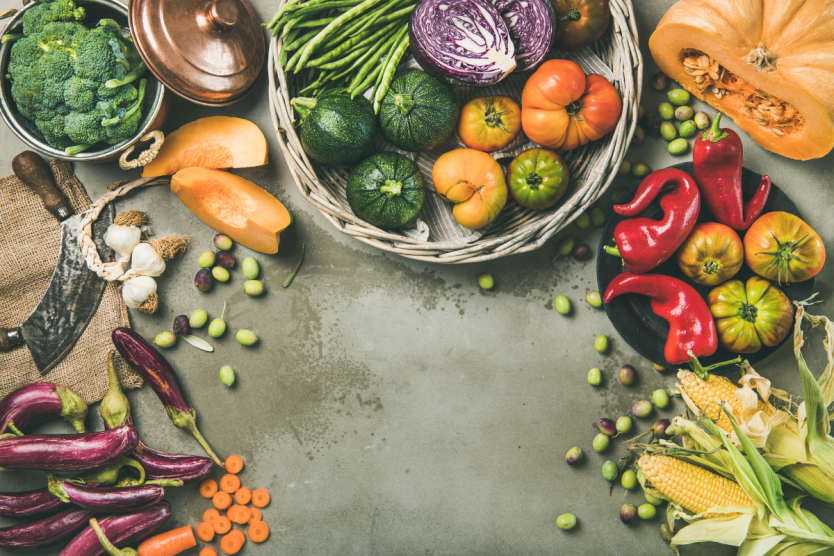A change in seasons often brings about a desire to make changes to our daily routines.
Autumn signals back to school for some, or back to a regular work routine after vacation time away from our jobs. A summer of overindulgence on too much alcohol, sugary drinks, and plenty of meals out might make you feel like doing a reset on your eating plan as well.
Changes to your meal routine don’t have to be major to have an impact. Here are 7 fall nutrition tips to inspire your meal planning.
1. Embrace Fall Foods
Even if you’re sick of pumpkin spice latte, or anything pumpkin spice, there are plenty of other foods in season in the autumn that can be added to your plate.
Sweet potatoes and yams are a fall favorite, as are other root vegetables like rutabagas, parsnips, beets, potatoes and carrots.1 Look for recipes to include them in casseroles or stews, or blend them into soups if the kids aren’t crazy about trying a new food. If you’re fortunate to live near fruit orchards, some fresh apple cider can be a treat—especially heated up on a cool autumn day.
Or try your hand at canning some beets or making pickles, which can be made refrigerator style if you’re not comfortable with processing them.2
2. Try Some New Whole Grains
Cooler weather can mean cravings for comfort food, like pasta and potatoes. Add some new whole grains to your meals for a change of pace, and a boost to your well-being. Whole grains provide an excellent fuel source, with essential carbohydrates for energy, while also increasing your fiber intake.3 Try your hand at a quinoa salad or barley soup.
3. Add Pulses to Your Grains
Nearly every culture has a version of “rice and beans,” and researchers have found that there are health benefits to combining complementary proteins that provide all the essential amino acids.4
Pulses like beans, peas, lentils, and chickpeas are a natural partner to whole grains, so try some of these variations:4
- The Mediterranean diet brings together hummus, made from chickpeas, with pita bread
- Latin Americans love black beans in particular, served with rice in various combinations
- A traditional African dish is jollof rice, a spicy one pot basmati rice and tomato dish that’s served with black-eyed peas
4. Go Meatless Once in a While
Even once a week, try a new recipe that doesn’t have meat in it. See tip #3 for some ideas for a complete meal that will boost your health and may help your pocketbook, as meat can be the most expensive part of any meal. At the very least, eliminate one meal a week that typically features red meat.
Research shows that people who eat red meat are at a higher risk of death from heart disease, stroke or diabetes, and processed meats make the risk of death from these diseases go up too. What you don’t eat can also be bad for your well-being. Diets low in nuts, seeds, seafood, fruits and vegetables can also make your health risks go up. Even eating less red and processed meat has a positive effect on health.5
5. Try Your Hand at Meal Prep
Autumn often means a return to activities for you and the kids, so you’ll be busy running to sports, music and school excursions. Take time each week to plan your meals, buy the essentials for the week, and do some meal preparation. It might seem like too much work on that day, but it will save you the rest of the week.
Even making a double batch of soup or a casserole, and freezing it into meal-sized portions to freeze, can make life easier when you’re too tired to think about cooking later in the week. It can also prevent the urge to pick up fast food or order in—both of which may cost more for your wallet and your health.
6. Boost Your Immune System
Autumn and winter can be the time for catching colds and the flu, particularly when the kids head back to school and we spend more time indoors. A healthy diet full of vitamins and minerals can boost your immunity, preventing illness and helping you bounce back sooner when you do get sick.6
Here’s a snapshot of foods that may help your immunity:6
- fatty fish
- citrus foods
- garlic
- ginger
- turmeric
- broccoli
- bell peppers
- spinach
- yogurt
- almonds
- sunflower seeds
7. Be Mindful of an Existing Condition
If you’ve got a specific medical condition that is helped by eating certain foods—and aggravated by other foods—then set an intention to follow a specific plan. Start with even one week, and see how you feel.
For instance, there are specific foods that can help ease menopause symptoms, while others might make the side effects worse. Some foods might help prevent polyps, or fibroids, while there are guidelines on foods to avoid if you have been diagnosed with Polycystic ovary syndrome (PCOS). Even more short-term conditions like a urinary tract infection (UTI) might benefit by avoidance of some types of food.
Talk To A Doctor
Your doctor can provide you with advice on a diet for a medical condition, or put you in touch with a dietician for additional resources. Use our Physician Finder to find a doctor near you with expertise in women’s health, who can help with nutrition tips all year long.




















